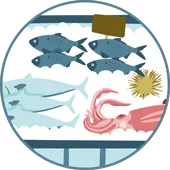







Aquaculture and fisheries affect the welfare of hundreds of billions of aquatic individuals every year. In 1986, the scientist Donald Broom used the term „welfare“ to describe the state of an animal. Welfare ranges from good to bad and includes health, feelings, whether the animal can perform natural behaviours, and more. The term „fish welfare“ is used in a scientific context.
In the fair‑fish database, we collect the scientifically available knowledge on fish welfare, process it into an overview, and assess how comfortable aquatic species may be in aquaculture („farm“ branch) and fisheries („catch“ branch).
In the farm branch, we compare the behaviour and needs of aquatic species in the wild with the conditions they are kept in in farms. From this, we determine the welfare of the individuals under minimal and currently the best possible conditions. For the assessment, we look at 10 meaningful criteria, which include the natural habitat, migratory behaviour, reproduction, aggression, and stress. The resulting „WelfareScore“ provides information on whether a species is suitable for aquaculture and how conditions can be improved.
In the catch branch, we analyse fish welfare during the phases of the catching process. Here, too, we differentiate between minimal and currently best possible catch conditions in order to identify potential improvements. We determine a „WelfareScore“ from 10 criteria, which include the detection of the fish, the deployment of the fishing gear, the catch itself as well as the release from the fishing gear, sorting, and storage. This score shows how many criteria indicate the risk of suffering. In total, we can conclude how well (or poorly) a species can tolerate the fishing conditions and how suffering can be reduced.
The fair‑fish database is a freely available source of knowledge and serves...
For further information, please visit the website of the fair‑fish database.

HomePublicationsThank you!Summer ShoalTeamfair-fish bookSocial mediaConsumptionDonateAssociationEventsData privacyOnline ShoalImprintfair-fish Marine schoolConsultancyWhich labels?Bequestfair tradePartnersArchiveAquaristicsJobs/InternshipsHistory & VisionCarefish/catchFisheryCarefish/farmFarmingfair-fish databaseImprintData privacyNewsTeamDid you know...?fish-factsAnnual reportsNewsletterMessagefish-facts SubscriptionInstagramFacebookTwitter / XLinkedIn


